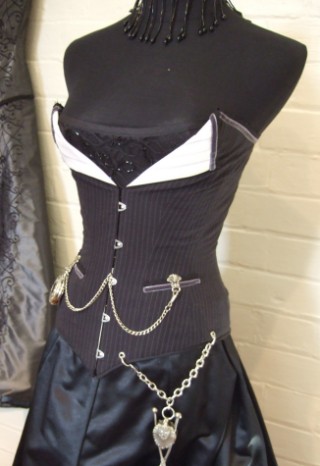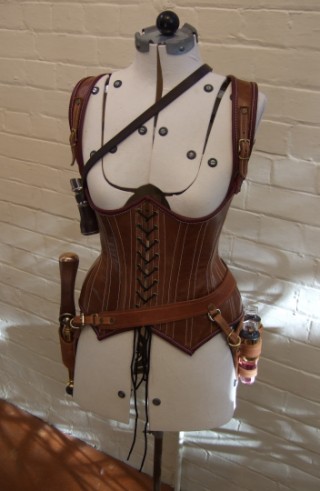Sometimes, no matter how difficult it might be, we need to accept that amusing stereotypes can sometimes prove true. So let's get it out of the way right from the start. Jo Drysdall is a librarian by day. By night she is Bastet Creations, maker of the most astoundingly beautiful corsets, and she is on a not-so-secret mission to bring sexy back.
Now, I know some of you are thinking, ew, corsets. Okay, sexy in a clichéd kind of way, but hideously uncomfortable and symbolic of the restricting of women's bodies for male appetites. About as classy or genuinely sensual as a Sexy Nurse outfit, right?

We'll have to agree to disagree, because I would wear that in a heartbeat. Try imagining someone wearing that being demure and repressed in anything but play.
Corset-making is an odd profession to find yourself in, and perhaps an odder one to have to refuse to take any more work in because you can't keep up with demand. Jo, through a History degree and an involvement in historical re-enactment, began making corsets along with other historical costuming about a decade ago. The history and construction of corsetry has become an insidious passion.
She's particularly fond of Edwardian and Victorian dress, which is convenient given the growth on interest in things Victorian, especially in Gothic and Fetish culture. Her most recent exhibition, "Corset", is inspired in part by steam-punk, the alternate Victorian science-fiction popularised by William Gibson and Alan Moore.
And what Victorian Adventuress would be complete without this?

There it is: corsetry as strength and power and daring. Despite our clichéd and simplistic views of repressive Victorian attitudes towards sex, that dynamic has always been there. Reading about the history of corsetry, it's difficult not to come to the same conclusion as Jo does:
Corsets have always had an ambivalent symbolism – on the one hand commentaries throughout the last 500 years associate them with chastity and moral restraint (think of the terms "straight-laced" and "loose woman") and yet at the same time they cannot help but be symbolic of female sexuality, with their various designs emphasising the breasts, hips and pelvis. They have always been a focus of male writers' conscious or subconscious obsessions and fears about women, power and sex. At any given time the corset tended to mirror attitudes held about women – it could be used as either a cause or sign of chastity or sexual promiscuity, vanity or modesty, assertiveness or repression.
Indeed, one of the strains of opposition to corseting during the Victorian period was based on the way corsetry interfered with a woman's prime purpose: having babies.
Surely, though, there is something legitimate in the other objections, that corsets restrict a woman's breathing and ability to move, that they pinch and dig in and are just plain uncomfortable?
According to Jo, most women's knowledge of what wearing a corset is like comes from wearing light-weight mass-produced corselettes, the kind that are mostly lace and plastic boning.
Corsets can feel a little odd to us, since we're used to stretch fabrics and loose clothing, but the feeling of being laced into a corset is actually rather nice – supportive and enveloping. They don't pinch or dig in, as they are designed to have a gentle all-over pressure… The bones are spring steel, much stronger than the plastic boning commonly found in formal gowns and corselettes these days. It can't buckle enough to dig in.
One of the things my clients all say when they try on their finished corset for the first time is (in tones of great surprise) "Hey, this is really comfortable!"
For the larger-chested woman, having the weight of your breasts supported by your whole torso instead of suspended from narrow shoulder-straps can actually be remarkably comfortable, and ease pain in the neck and upper back.
Still, there is some restriction when it comes to bending. Jo gives one sage piece of advice to her clients: boots first, then corset.
And not all Jo's clients are women. Some of the corsets she has made for men are to fit a natural male shape, others were made for cross-dressers and designed to emulate a more female shape.
Nevertheless, she still occasionally has problematic reactions to her work. Despite designing for men and women of all body types, she has been accused of making 'prostitutes' clothing'. At the other end of the spectrum, at her first exhibition she found her work being viewed as simply art, static display pieces, by people who were astonished that they were intended for wear. That's perhaps understandable: Jo’s work is both beautifully crafted and simply beautiful.
Attitude problems are always going to persist when it comes to corsets, even though they’re now worn by women who freely choose to wear them and feel attractive and powerful in them.
Given that corsets can and are worn by women of every shape and size (and make the most of every sort of figure!) I’d say they do more for a positive and realistic female self-image than the unrealistically thin models of our catwalks do.
A corset is just an item of clothing, onto which people tend to project their attitudes to the real women who have worn and do still wear them.
Jo Drysdall’s Corset exhibition runs at the Arts Centre in Christchurch until the 20th. Get along if you can: photographs cannot do justice to the astonishing artistry and the sheer sense of fun that goes into these works. Photographs used here are by Phil Anderson. You can see more photos of Jo’s exhibition here and here.